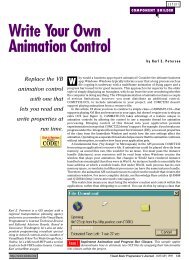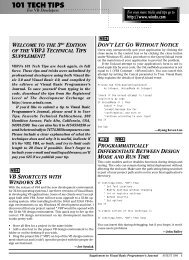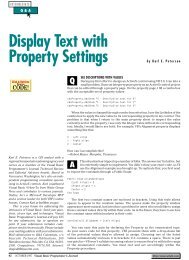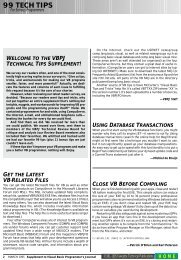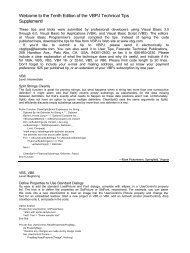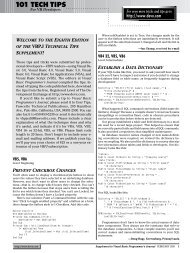101 Tech Tips - Visual Studio Magazine - One-Stop Source Shop
101 Tech Tips - Visual Studio Magazine - One-Stop Source Shop
101 Tech Tips - Visual Studio Magazine - One-Stop Source Shop
- No tags were found...
You also want an ePaper? Increase the reach of your titles
YUMPU automatically turns print PDFs into web optimized ePapers that Google loves.
<strong>101</strong> TECH TIPSFor <strong>Visual</strong> <strong>Studio</strong> DevelopersVB5, VB6Level: BeginningLet VB Spell the Control Name for YouI love the way VB’s IntelliSense drops down a list of control names,properties, and methods as soon as I type the period after theobject’s name. But when you’re coding in a form’s own module andreferencing the control name directly, without an object qualifier,you can still get that cool dropdown list. First type “Me.” (with theperiod) and pick the name. Feel free to delete the “Me.” qualifierlater. Here’s an example:Call clsDatabase.LoadMyListBox(Me.MylistBox)VB4/32, VB5, VB6, VBS, SQL 7.0 and upLevel: Intermediate—Frank Ramage, Laurel, Md.Preprocess Nulls in Your RecordsetI’ve seen several examples of VB code dealing with nulls inrecordsets before the value is assigned to a VB control. I often usethe Transact-SQL IsNull statement when working with SQL Server(version 7.0 and later) queries. SQL Server uses IsNull to deal withthe null value if it arises so I don’t have to write additional code tohandle nulls when I process a recordset. For example, in this codethat reads CustomerID and EmailAddress from a Customers Table,SQL Server returns the value “na” if the EmailAddress field is null:set rsCustomerDetails = cn.Execute("Select " & _"CustomerID, IsNull(EmailAddress,'na') as " & _"EmailAddress from Customers")You can’t update the recordset because IsNull appears in theSelect statement. But you’ll find many circumstances where thisdoesn’t matter, such as when using VBScript to build a table in aWeb page.—Robert Bryan, Downer, Australian Capital Territory,AustraliaVB5, VB6Level: IntermediateAdd a Picture Preview Property PageDefining a public property in a user control as Picture (or StdPicture)provides the standard ellipsis next to the property name in VB’sproperty viewer automatically. This pops up a standard dialog toload an image control.Let’s say you have this code in a user control:Public Property Get Picture() As PictureSet Picture = UserControl.PictureEnd PropertyPublic Property Set Picture( _ByVal newPicture As Picture)Set UserControl.Picture = newPicturePropertyChanged "Picture"End PropertyYou can add a standard VB property page to the control thatprovides the standard preview window so you can see what you’reloading. To do this, you open the UserControl in design mode andselect the PropertyPages property. You’ll see a dialog with threeor four choices: StandardPicture, StandardFont, StandardColor,and (for VB6) StandardDataFormat. Simply check the ones youwish to have a custom property added to the UserControl’s otherproperties. Note: Just because you add the property pages doesn’tmean you can access them immediately. You need to assign thepage to specific properties using the Procedure Attributes dialog.VB6Level: IntermediateSplit Strings Cleanly, ReduxIn the 10 th Edition of the “<strong>101</strong> <strong>Tech</strong> <strong>Tips</strong> for VB Developers”supplement [<strong>Visual</strong> Basic Programmer’s Journal February 2000],the “Split Strings Cleanly” function splits an array containing morethan one delimiter in a row efficiently. This functions works greatfor one delimiter, but what if you want to split an array on morethan one delimiter? Adding a few lines of code and using recursioncan enhance the function to handle multiple delimiters.When more than one delimiter is passed into the function, yourejoin the filtered array using the next delimiter, drop the currentdelimiter from the delimiter list, and call the function again:Public Function CleanSplit2( _ByVal Expression As String, _Optional ByVal Delimiters As String = " ", _Optional ByVal Limit As Long = -1, _Optional Compare As VbCompareMethod = _vbBinaryCompare) As VariantDim Substrings() As StringDim <strong>One</strong>Delimiter As StringDim I As Long<strong>One</strong>Delimiter = Mid$(Delimiters, 1, 1)Substrings = Split(Expression, <strong>One</strong>Delimiter, _Limit, Compare)For I = LBound(Substrings) To UBound(Substrings)If Len(Substrings(I)) = 0 ThenSubstrings(I) = <strong>One</strong>DelimiterEnd IfNext IIf Len(Delimiters) = 1 ThenCleanSplit2 = Filter( _Substrings, <strong>One</strong>Delimiter, False)ElseCleanSplit2 = _CleanSplit2(Join( _Filter(Substrings, <strong>One</strong>Delimiter, False), _Mid$(Delimiters, 2, 1)), _Mid$(Delimiters, 2), Limit, Compare)End IfEnd FunctionVB3, VB4, VB5, VB6Level: Intermediate—Stephen Sayabalian, Waltham, Mass.Keep Your Projects IntactVB has always gone out of its way to take care of mundanehousekeeping tasks without bothering you with the details. Butsometimes the best intentions can create unintended problems.When you work with a project, VB automatically keeps track of theproject’s files by maintaining their entries in the VBP project file(MAK in VB3). When you move files around or bring in files fromother projects, VB edits the path information for those files,sometimes creating an incomprehensible mess of upward-movingrelative paths littered with “\..\” steps. The result can be catastrophic—youcan inadvertently edit a different project’s sourcecode, or you can end up missing files when you move a project toanother directory or computer. To avoid these problems, firstmake sure all your working files are in the directories you intended,then edit the VBP file manually in Notepad to remove anyvisually ambiguous path descriptions. Make sure you exit the VBIDE before editing the VBP file.—Ron Schwarz, Hart, Mich.—John Cullen, Pedroucos, Portugal2 Supplement to <strong>Visual</strong> <strong>Studio</strong> <strong>Magazine</strong> SEPTEMBER 2001



